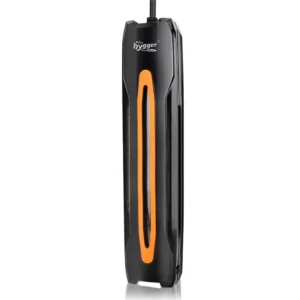Hey, dear friends, do you still remember we have covered one special freshwater fish before, which may be difficult to breed? Yeah, that is puffer fish, such as Pea puffers, Red-eye puffers, and Congo puffers. In today’s article, we will share the tiny mighty dwarf pufferfish – pea puffers.
Content Table
The Tiny Mighty Pea Puffers
Brief info about pea puffers
Featuring a small size and light green body with black spots, pea puffers are popular among aquarists. As the smallest pufferfish, they have a large head and the body gets smaller towards the tail. Besides, dwarf pufferfish are active, aggressive, and sensitive. Consequently, it is recommended to keep them alone in a fish tank with great water quality and stable water parameters. Next, let’s learn more about pea puffers in the table below.
| Family | Tetraodontidae |
| Scientific name | Carinotetraodon Travancoricus |
| Common names | Pygmy puffers, Pea puffers, Dwarf puffers (dwarf pufferfish), Indian dwarf puffer |
| Origin | Western India |
| Water temperature | 74-82℉ (23-28℃) |
| pH level | 7.0-7.6 |
| Size | usually less than 1.5 inches |
| Diet | Carnivore |
| Lifespan | 3–4 years |
| Temperament | Aggressive |
| Minimum tank size | 10 gallons |
Interesting facts about pea puffers
- Pea puffers are small, which are usually less than 1.5 inches.
- Though pea puffers are small, they are aggressive and territorial.
- They are sensitive to water condition fluctuation, hence, regular monitoring and maintenance are vital.
- Pea puffer puff up: In the face of stress and shocks, puffer fish inflate themselves with water or air.
- They are intermediate-level fish. Because they demand special food requirements and are less compatible with other fish.
- It is said that pea puffers can recognize their owner.

What Do Pea Puffers Eat
How big do pea puffers get? Generally, pea puffers reach less than 1.5 inches. Then, What do pea puffers eat? Seeing that, pea puffers are carnivorous. Thus, worms, bloodworms, mosquito larvae, brine shrimp, snails, live shrimps, small feeder fish, and frozen food are available.
However, no matter what they eat, a proper and balanced diet is vital. It is recommended to feed small amounts more frequently to avoid overfeeding. For instance, twice per day, with a half portion each time. In addition to meat, it is feasible to feed some vegetables from time to time. For example, once or twice per week. Besides that, food with a rigid substrate is also needed, which helps limit tooth growth. For instance, snails, crustaceans, or shellfish. Because puffer fish teeth will keep growing as they get older.
How Many Pea Puffers Are in a 10-gallon Tank
Commonly, pea puffers are not challenging to maintain in aquariums. Nevertheless, a comfortable environment, a proper diet, suitable tank mates, or something like that is necessary.
Usually, a large aquarium is better, which decreases the risk of water parameter fluctuation and provides sufficient space for pea puffers to swim and explore. Take the minimum 10-gallon fish tank as an example, you could hold 1-2 pea puffers in the tank. However, it is best to keep 3 pea puffers in an aquarium. For instance, one male pea puffer and two females. But in this case, a larger tank would be better.
Moreover, adequate hiding places in an aquarium are also crucial for them. Because pea puffers live in areas with dense vegetation in the wild. Accordingly, you can decorate your pea puffer aquariums with some aquarium decorations, like caves, rocks, hollow tree trunks, and aquatic plants. As for the aquarium substrate, small gravel is a great alternative. While adding a level of aquarium soil is helpful for plants’ growth. By the way, aquatic plants, like Java moss, are excellent options for pea puffers aquariums.

Furthermore, pea puffers are sensitive to changes in water parameters. Consequently, you should regularly monitor the aquarium water by testing the water parameters. Also, adding an aquarium filter may be essential, which is beneficial to keep clean water. Also, an aquarium heater will help to maintain a stable water temperature. Commonly, pea puffer aquariums’ water temperature should be between 74℉ and 82℉. An ultra-short aquarium quartz heater is feasible. With a thermostat controller and a control range of 59-93℉, it is ideal for 5-160 gallon freshwater tanks.
Besides that, pea puffers fancy dim light. Nonetheless, some aquatic plants may need intensive light. As a result, it may lead to an issue to keep a light balance between the fish and plants. Luckily, you can choose some floating plants or add low-light aquatic plants to tackle the problem.
Additionally, fish compatibility should be taken into consideration. Pea puffers are the smallest pufferfish but are aggressive. It is best to keep them alone. But it is feasible to keep them with fast-moving fish, like danios. Other feasible tank mates include neon tetras, adult cherry shrimp, and Kuhli loaches. Conversely, slow-moving fish and fish with long fins should be avoided. Because pea puffer will nip fins, or disturb fish moving slowly. Aside from that, can pea puffers be a great addition to community aquariums? It depends on the tank mates in the community tank. Keep in mind – be cautious when introducing tank mates to pea puffer aquariums, and the fast-moving fish is the first choice.
Final Thoughts
Pea puffers can be easy to care for, but not a good choice for beginners. Because you should be cautious about the tank mates, and food. By the way, if you want to learn more about freshwater puffer fish, you can go to the Most Popular Types of Freshwater Puffer Fish. That’s it. Thanks for taking the time, and we hope this article helps.


Leave a comment